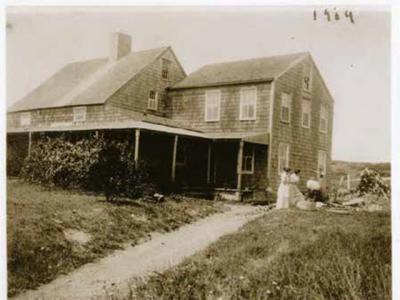Second House to Be Restored

Second House, the oldest structure in Montauk, will benefit from a $450,000 restoration project, the East Hampton Town Board announced at the close of its business in 2018.
At its Dec. 20 meeting, the board accepted a bid of $453,442 from Ronald Webb Builder of East Hampton for the first phase of a restoration that will focus on the foundation, first-floor frame, and removal of nonhistorical additions, according to Robert Hefner, a historic preservation consultant and East Hampton Village’s director of historic services. Councilman David Lys said at the town board’s work session on Tuesday that the work might begin as soon as next month.
A 2016 report prepared by Mr. Hefner said that in its present state, Second House, adjacent to Fort Pond on the western edge of Montauk’s downtown, more closely resembles an early-20th century summer cottage than the residence of livestock keepers it was in the 18th and 19th centuries. The timber frame has deteriorated, wiring and plumbing are obsolete, and “an infestation of raccoons and other animals in the attic and cellar has made the cellar inaccessible and has tainted the air to make the interior inhospitable to visitors.”
“It is the recommendation of this report that the Second House be restored to its appearance in 1886 when George A. Osborne, the last keeper employed by the proprietors of Montauk, departed,” Mr. Hefner wrote. “The essential work would be removing the 1912 east addition, dormers, and porch, and reconstructing the early east lean-to (of which some framing remains) and reconstructing the circa 1880 porch.” Also recommended are clearing the animal infestation, testing for and removal of material containing asbestos, and installation of new plumbing, electrical, and, possibly, a heating, ventilation, and air-conditioning system.
The barn on the property, built in 1809, also needs a complete restoration of its timber frame, Mr. Hefner said, and removal of the privet hedge on the east property line would enhance the setting.
Second House was built in 1746, when Montauk was pastureland. It was replaced in 1797, when the town allotted “three gallons of rum to raise the house at Fort Pond,” according to town trustee records. The keeper of Second House was responsible for tending sheep to the west and cattle to the east, according to Henry Osmers, historian of the Montauk Historical Society. Further alterations to the structure were made in 1879, 1880, and 1912.
In 1968, the town and the New York State Historical Trust purchased Second House for $75,000 from the David Kennedy family, which acquired it early in the 20th century and used it as a summer residence. It opened as a museum the following year under management of the Montauk Historical Society, but was closed in recent years due to its dilapidated condition. Twice-yearly craft fairs on the grounds are a popular draw in the summer. Those will continue, Mr. Lys said on Monday, whether or not the restoration is underway. Mr. Lys, who played a prominent role in the Amagansett Life-Saving and Coast Guard Station’s restoration effort, also encouraged public participation in the restoration of Second House. “What I found with the Life-Saving Station,” he said, “is that once you start getting the hypothetical snowball rolling, it only gets better from there. We hope community members will step up in kind and do some potential work along with the town.”
Montauk’s First House, built in 1744 and rebuilt in 1798, was located where Hither Hills State Park stands today. It was destroyed by fire in 1909. Third House, still standing two miles west of Montauk Point at what is now Montauk County Park, was built in 1747 and replaced in 1806.
Once it has reopened, Second House is to offer educational programs for elementary and high school students.
